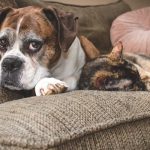Senior Cats
Senior Cat Health Screen
For all cats over ten years, we offer a health screen which we hope will pick up problems early and help them live much longer.
High blood pressure is a silent killer in many cats causing damage to the kidneys, blindness through retinal detachment and heart disease. Cats are often presented when the damage is already done.
By measuring blood pressure and testing a urine sample we can screen for diabetes, early renal disease, hypertension and lower urinary tract infections.
We now have blood tests available to pick up heart disease and early kidney damage
For the price of £56 the Senior Cat Health Screen by our nurses will include
- Weight measurement
- Dental check
- Basic urine testing
- Blood Pressure Measurement
- Blood tests to detect early kidney damage (SDMA) and heart disease (proBNP)
To do this we will ask for your cat to come and spend a few hours with us one morning. This allows them to settle in so we can get the most accurate results from them when they are calmest. If possible we ask you to collect a urine sample in advance, let us know if you need advice on how to do this.
If we have any concerns based on the results from this screening our vets will discuss with you any further investigations or action that may be needed.
Looking After Senior Cats
|
Life stage |
Age in cat years |
Age equivalent in human years |
|
Senior |
11 |
60 |
|
12 |
64 |
|
|
13 |
68 |
|
|
14 |
72 |
|
|
Geriatric |
15 |
76 |
|
16 |
80 |
|
|
17 |
84 |
|
|
18 |
88 |
|
|
19 |
92 |
|
|
20 |
96 |
When a cat is brought to us for a consultation or vaccination this is an important opportunity to give them an examination and to discuss their health with their owners. This is important for all the animals that we see but even more so as they enter their senior years.
Although they can seem very well cats can often hide signs of illness until they are feeling very unwell. As small lone hunters in the wild, without a pack to protect them, it is a real disadvantage to show weakness.
With cats that spend time outdoors it can also be hard to be certain of changes in their eating, drinking and toileting habits. Reduced activity in older cats can also be easily attributed to old age rather than to any medical problems which could be underlying.
Senior cats are also much more likely to develop several serious medical conditions. Some of the diseases we need to be alert to with older cats are listed below
Chronic renal failure
The signs of this can include weight loss, increased thirst, reduced appetite and halitosis but often these signs do not become obvious until the disease is more advanced. We use urine and blood tests to assess renal function.
Caught early on in the process we can make changes to their diet to reduce the work load of the kidneys. We can also look out for the side effects of kidney disease, such as high blood pressure, anaemia and protein loss in urine, and manage them.
While we cannot ‘cure’ renal failure we can try to stabilise and manage it to give patients a good quality of life for as long as possible.
Diabetes mellitus
As cats age, particularly those that have been overweight, their insulin stops being as effective at this job. Their pancreas produces more and more until it becomes exhausted no insulin is available to control the cats blood sugar.
High sugar levels in their blood pass out into their urine, taking water with it, leaving them with an increased thirst to replace this water.
Although they have lots of sugar in their blood their body is unable to use it so they are often very hungry despite losing weight.
Diabetes can be managed with diet changes and daily insulin injections by owners giving these cats a good quality of life.
Hyperthyroidism
Hyperthyroidism in the Cat
A disease developing in middle-aged/older cats, usually over the age of 10years, caused by an overactive thyroid gland
Signs of hyperthyroidism
Weight loss, increased appetite, increased thirst, rapid heart rate and hyperactivity are the most common signs. Some cats will have vomiting and diarrhoea. A small minority of cats will become lethargic and lose their appetite
Diagnosis
The signs seen with hyperthyroid cats are not always specific to the disease. Particularly as most of the patients are older cats other problems such as kidney disease and diabetes need to be ruled out first by blood tests run in the practice.
A hyperthyroid cat may have increased liver enzyme levels on these tests. If we are suspicious of hyperthyroidism we check a blood sample to measure the level of thyroid hormone (T4). A high T4 level gives us the diagnosis for a hyperthyroid cat.
Why is treatment important?
An overactive thyroid gland causes an increase in the metabolic rate of the cat, causing them to lose weight despite excessive eating. The excess thyroid hormone also has adverse effects on many of the organs, particularly the heart.
Affected cats will have a fast heart rate and their heart muscle becomes thickened, which can lead to heart murmurs, changes in heart rhythm and eventually heart failure. In most cases treatment of the hyperthyroidism can reverse or reduce these effects on the heart.
Treatment Options
There are three main ways of treating hyperthyroid cats – medical, surgical and radioiodide treatment, which is chosen depends on many factors including cost, ability to give tablets to the cat and other health problems.
- Medical Management
This is achieved by tablets given daily to the cat. Tablet products available for this are – Felimazole, which is given once or twice daily OR Vidalta, which is given once daily. They can be given directly by mouth or whole in food but cannot be crushed. There is also a liquid form Thyronorm which some owners find easier to administer.
The dose required varies between cats so often we need to monitor the T4 levels frequently at first to find the dose giving best control in each patient. We also monitor improvement by heart rate and weight gain.
This method of treatment is NOT curative, it controls the overactive thyroid gland. If medical treatment is chosen for long term management for the cat then tablets will need to be given for life. Once stable on a particular dose cats are monitored by check ups at regular intervals including checking their T4 levels as necessary.
Medical treatment is also important for stabilising the condition in cats before other methods of treatment, even if it is not going to be used long term.
Medication can help to reduce the effects of thyroid hormone on the heart, reducing some of the anaesthetic risks before surgical treatment. It can also allow us to check for any change in kidney function after treatment of the condition.
Kidney insufficiency is common in older cats and in some cases the increased blood flow to the kidneys in hyperthyroidism can be masking the blood changes seen in renal failure. If we see this happen after medical treatment we can adjust the treatment plan to manage both conditions as well as possible.
- Surgical Treatment – Thyroidectomy
This involves a general anaesthetic and surgery to remove the affected gland(s). An incision is made on the underside of the neck and one or both glands are removed. Often we are unable to tell if one or both glands are affected until they are seen during the surgery.
This is usually curative, although where the problem is initially in one gland only it can recur in the other gland later on in life. As most cats can be difficult to give tablets on a long-term basis surgery is usually the best option for most patients.
If owners cannot give tablets at all to their cat we can perform the operation without initial stabilisation on medication but there is an increased risk with the anaesthetic. In some cases we can hospitalise the cat for a few days first for medication to be given to allow some reduction of the risk.
- Radio-iodide treatment
A specific radioactive form of iodine is given to the cat which selectively removes the overactive thyroid tissue without the need for surgery or long term medication.
This involves the patient being hospitalised for about 10 days at a special treatment centre to allow the iodine to be cleared from the system. Previously this was only available in Cambridge, Glasgow and Edinburgh but there are now centres in Wetherby and Chester.
We have referred several patients to the Hyperthyroid Cat Centre in Wetherby for treatment. This is non-invasive and avoids the anaesthetic and surgical complications of thyroidectomy but is more expensive. Following treatment blood thyroid levels and kidney function are monitored periodically for 6-12months.
Are there any problems with treatment?
- Medical management
- Having to give medication daily
- Long term costs of tablets and monitoring
- Some cats experience side effects such as vomiting and lethargy but these usually respond quickly to stopping or reducing dose of medication
- Unmasked kidney failure – monitoring of kidney levels after thyroid treatment is important as already discussed. There is no evidence to suggest that thyroid disease should be under treated due to unmasked kidney disease. Our aim is to keep thyroid hormone levels within normal range and manage the kidney disease with other medical treatment
- Risk of thyroid tissue becoming cancerous – at diagnosis most cats have benign overactive thyroid tissue but there have been reports that after many years this tissue can become cancerous. Due to the time scale involved this is more of a concern for cats that are younger at diagnosis and could be on medical treatment for a long time
- Surgical treatment
- Anaesthetic and surgical risk, can be minimised by medication to stabilise cat prior to operation
- Cost of surgery, although initially this may seem costly it saves on long term costs of medication. Cost can be claimed back for insured cats
- Recurrence of hyperthyroidism can occur if the second gland later becomes overactive (if only one removed) or occasionally after both glands are removed there can be extra thyroid tissue elsewhere in the body which can become overactive. This can be treated by a surgery to remove a second gland or if both glands already removed the cat will need medical or radio-iodide therapy
- Thyroid hormone deficiency very rarely happens as there is small amounts of thyroid tissue elsewhere in the body which take over hormone production
- Unmasked kidney failure, medicating before surgery may highlight this and allow us to assess if surgical treatment is still the best option. While the thyroid condition still needs treating it may be decided that a general anaesthetic for surgery is better avoided and other treatments considered
- Low calcium levels – the thyroid glands are closely attached to the parathyroid gland which controls calcium levels. Surgery can sometimes affect this gland temporarily or permanently, leading to problems of calcium control if both thyroid glands have been removed (bilateral thyroidectomy). In patients where this happens we see a low calcium level days to weeks post surgery. Severity varies and signs include twitchiness, reduced appetite, irritability and occasionally in severe cases fits, although usually owners mainly notice a change in personality of the cat. This does not happen in all patients but it is important for owners to be aware of the signs so it can be treated as early as possible. Treatment is initially by calcium given intravenously and then by prescribed oral calcium and vitamin D supplements. In many cases it is temporary or intermittent and the cat will eventually regain normal calcium control.
- Radio-iodide therapy
- Hospitalisation for a period
- Travel for treatment
- High cost – this option can be expensive in the short term but usually avoids the need for ongoing medical treatment costs. Costs can be reclaimed for insured cats
- Unmasked kidney failure – Kidney function is thoroughly assessed before and after radioiodine treatment to allow any unmasked kidney insufficiency to be managed alongside treatment
Hypertension
Whilst high blood pressure can be a problem in its own right it can also be a sign or complication of other diseases including chronic renal failure, diabetes, hyperthyroidism, heart conditions and a hormonal condition called Conn’s Syndrome.
Osteoarthritis
Although osteoarthritis was traditionally thought only to be an issue in dogs we are now appreciating that it is a problem in a large proportion of older cats. Common joints affected include elbows, stifles and intervertebral joints of the neck.
Due to their more sedentary lifestyle signs of arthritis in cats can be much more subtle and are often mistaken for old age. They include lameness, reduced activity levels, unkempt coat due to reduced grooming, inability to get into litter tray properly and bad temper when being stroked or handled.
Joint supplements such as glucosamine are available for cats in liquid or tablet form. There is also a licensed NSAID for oral use for long term pain relief (meloxicam).
Again, due to the potential for effects of these drugs on the kidneys we advise a screening blood test prior to long term use. For cats who are unable to tolerate meloxicam we have other medications such as gabapentin. Although gabapentin is not available as an animal licensed product it can be used ‘off license’ to provide pain relief for those patients that need it.
Paracetamol MUST NOT BE USED in cats as it is highly toxic.
The most recent advance in osteoarthritis treatment is Monoclonal antibody therapy. As with the treatment in dogs these antibodies target nerve growth factor in the joints to reduce pain and inflammation. The treatment is given by monthly injection and can hopefully provide a safe effective alternative to other arthritis medications. The injection for cats is called Solensia.
Many owners see a marked improvement in the quality of life of their older cats with management of their arthritis.
Dental disease
They also have a unique dental problem known as ‘neck lesions’ where small holes develop in their enamel and eventually deepen to affect the sensitive part of the tooth.
These lesions can be very painful but for the reasons discussed earlier few cats show obvious signs of dental pain.
Neck lesions can also be hard to see for an owner as they can be under the gum line or beneath tartar. Affected teeth need extraction under general anaesthetic to relieve discomfort.
Dental disease is also important as it has been linked as a contributing factor to kidney disease.
Cardiomyopathy
As a lot of older cats have reduced activity levels any signs of heart problems can be hard to appreciate for an owner until it is fairly advanced.
If the vet hears abnormal sounds or rhythms when listening to your cat they may recommend further tests such as an ultrasound scan of the heart.
The most common problem is a thickening of the heart muscle which can initially be without external signs but eventually lead to heart failure and clots developing in the heart. While there is no treatment currently which can prevent or delay heart failure we can use medication to prevent clots in patients that are at risk.
We can also give owners information on the signs to look out for to suggest the heart is starting to deteriorate.
In addition to being more prone to these diseases it is also recognised that older cats often suffer from a combination of them. The conditions discussed above can present serious issues for anaesthesia which is why we advise pre-anaesthetic blood tests in older patients.
Other more specific tests such as thyroid testing and heart scans may be advised if the vet feels further investigation is needed for a patient. More information on all of these diseases is available on the owners section of the international cat care website (www.icatcare.org)





